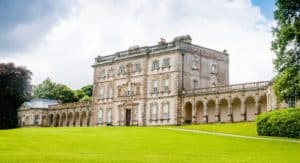Irish Folktales and Their Moral Lessons: Unveiling Timeless Ethical Wisdom

Updated On: April 15, 2024 by Fatma Mohamed
Irish folktales are an integral part of Ireland’s cultural fabric, weaving together the threads of mythology, art, and morality into a rich tapestry of storytelling. These tales have travelled through the ages by word of mouth, preserving thrilling adventures and encounters with the supernatural and encapsulating essential moral lessons. The characters that populate Irish legends embody the virtues and vices that resonate through time, serving as both entertainment and ethical guideposts.
Table of Contents

Through folktales, we explore the interplay of nature and the supernatural, as well as their influence on everyday life in Ireland. The stories, often set in a world where mystic forces are at play, offer insight into human nature and the complexities of the human condition. Our enthralling tales of heroes, fairies, and mythical creatures continue to be a source of fascination and have secured a place in modern media, reflecting their timeless appeal and the endurance of their messages.
The Roots of Irish Folktales

Irish folktales are a luminous thread in the fabric of Irish culture, woven through the centuries to connect Ireland with its mystical past. Emerging from the Celtic tradition, these tales carry with them the whispers of the Celts and the essence of a community bound by storytelling.
Oral Tradition: Central to this legacy is the oral tradition, a practice whereby stories were passed from generation to generation. Before the written word became commonplace, it was the fireside gatherings and communal meetings where such tales were recited, ensuring the preservation and continuance of lore integral to Irish heritage.
Traditions and Folklore: Within these stories are the nuances of Irish culture — a tapestry of heroes, faeries, and morals that have shaped the nation’s identity. They reflect a much older Ireland, one steeped in the rituals and beliefs of the Celts.
| Element | Role in Folktales |
|---|---|
| Community | Keeper of folklore, passing it down |
| Celts | Originators of the core narratives |
| Generations | Transformers of tales with each retelling |
Generations and Lessons: Through the repetition and reverence of these stories, each generation has imbibed the wisdom of the community, transforming the folktales through time while keeping their essence alive. The morals rooted in this tradition serve not only as a guide for moral conduct but also as a vessel for shared experiences.
Embedded in Irish folktales is the lifeblood of a people, telling of triumphs and tragedies that have resonated through the ages. Our retelling of them today strengthens the link to our past and carries forward the values embedded in their narratives.
Classic Characters of Irish Folklore

Irish folklore is teeming with enchanting characters, each embodying the values, culture, and beliefs of Ireland. From mischievous fairies to awe-inspiring heroes, these legendary figures have been inspiring tales for centuries.
Leprechauns and Fairies
Leprechauns are renowned for their cunning and playfulness and famed for the pots of gold they purportedly hide. Traditionally, leprechauns are cobblers and are often depicted in green attire. In contrast, fairies in Irish folklore, also known as the Aos Sí, represent a supernatural race akin to the Tuatha Dé Danann, with various types having their own societies and powers.
Banshees and Ghostly Apparitions
The Banshee, or Bean Sídhe, is a pivotal supernatural figure in Irish lore. Known as the wailing woman, she is believed to foretell death with her mournful cry. Her presence is linked to specific families, and her lament is seen as an omen.
Giants and Heroes
Renowned giants and heroes like Fionn Mac Cumhaill and Cú Chulainn occupy significant chapters in Irish myths. Fionn Mac Cumhaill, a celebrated warrior of the Fenian Cycle, was known for his wisdom and leadership. Cú Chulainn, a central figure in the Ulster Cycle, was a demigod known for his superhuman prowess and the epic tale Táin Bó Cúailnge associated with his heroic deeds.
Gods and Goddesses
The pantheon of Irish gods and goddesses mainly stems from the mythological race called Tuatha Dé Danann. These deities, once worshipped in ancient Ireland, are often associated with natural phenomena, various skills, and warfare. Their stories have withstood the test of time, reflecting the spiritual and moral fabric of ancient Irish society.
Moral Themes in Irish Legends
Irish legends are rich with moral themes that resonate through their narratives, teaching us about the complexities of the human condition.
Lessons of Love and Betrayal
The tales often weave together intricate plots where love and betrayal clash, imparting wisdom about the joy and pain of human relationships. One common thread is the tragedy of love unrecognised until it’s too late, a poignant reminder of love’s elusive nature.
Bravery and Sacrifice
The sacrifices heroes make in the name of bravery are central to many stories, where protagonists often face insurmountable odds. Such legends encourage resilience, underlining that true courage involves not the absence of fear but the strength to confront it.
Loyalty and Kinship
Lastly, the virtue of loyalty and the bonds of kinship are extolled as foundational pillars of society. From family ties to communal bonds, these tales often stress the moral imperative to uphold these connections, reinforcing their irreplaceable value in our lives.
Nature and the Supernatural
In Irish folklore, the natural world is often intertwined with elements of the supernatural. Here, we examine how landscapes are enchanted and how otherworldly realms and entities are a core part of this rich tradition.
The Enchanted Landscape
Our landscapes hold more than meets the eye; they are the canvas for countless tales where nature and supernatural elements merge. Ireland’s verdant hills, mysterious lakes, and rugged coastlines become settings for encounters with fairies and gateways to enchanted realms. In these stories, Tír na nÓg emerges as the timeless land of youth, hidden within these very vistas, accessible to a few fortunate souls through mystical means.
- Fairy Forts: Circular earthen mounds dotting Ireland’s countryside, believed to be the homes of fairies and other spirits.
- Selkies: Mythical creatures, seals in water but humans on land, who are said to live along the Irish coasts.
Otherworldly Realms and Entities
The concept of the Otherworld is pivotal in our folklore. It is a realm parallel to our own, inhabited by deities, fairies, and various other mystical beings. This world is often accessed through ancient monuments or specific times of the year, like Samhain, when the veil between worlds is thinnest.
- Otherworldly Passage: Sites like Newgrange or the Hill of Tara are believed to be gateways to the Otherworld.
- Entities: The Tuatha Dé Danann, a pantheon of gods from the Otherworld, and the Aos Sí, fairies protecting the natural world, reign within this mystical domain.
Infusing Mythology into Everyday Life

We often see the seamless integration of ancient mythology within the fabric of modern Irish life, particularly through vibrant festivals and deep-seated rituals and superstitions.
Festivals and Celebrations
Irish mythology breathes life into our festivals, where the sacred and the secular meld. St. Patrick’s Day stands as a prominent example, blending Christian and pre-Christian traditions. Parades and green attire echo the reverence for St. Patrick, while some practices during the day hark back to older, mythological roots. The spirit of the festival transcends religious boundaries, becoming a celebration of Irish identity itself.
Similarly, Samhain, which inspired Halloween, showcases a blend of the sacred and the profane. Bonfires and costumes may seem entertaining, but they also connect us to rituals meant to protect against spirits – a superstition rooted deeply in our belief system even today.
Rituals and Superstitions
Beliefs and superstitions are subtly woven into the rituals of our daily lives. The piseógs, or traditional superstitions, though not strictly religious, carry the weight of centuries of belief. For example, turning a shoe upside down so it does not face the sky is a simple act performed to avoid bad luck.
Even our language is infused with mythology. Casual references to the little people, also known as fairies, surface in conversation, suggesting an ever-present, if not entirely earnest, acknowledgement of the old ways.
- Rituals Reflecting Superstitions and Beliefs:
- Avoiding the fairy forts
- The not turning of a shoe superstition
Through these traditions and everyday rituals, the echoes of our forebearers’ mythology perpetuate, grounding us in a cultural narrative that has withstood the test of time.
Preservation of Irish Folktales
In safeguarding the rich tapestry of Irish folktales, we recognise the pivotal roles of both the traditional raconteurs and the transition to written records, crucial for the continuity of these cultural treasures.
The Role of Storytellers
The preservation of Irish folk tradition owes much to storytellers, often known as seanchaí. These individuals were guardians of folklore and history, entrusted with the responsibility of passing down tales through generations. Their narratives weren’t merely for entertainment; they served as vessels of education and cultural identity, embedding moral lessons and capturing the essence of Irish life. In schools and gatherings, these storytellers played a foundational part in the oral transmission of folktales, ensuring that the wisdom and heritage encapsulated in these stories remained vibrant and accessible.
From Oral to Written
As times evolved, so did the methods of preserving Irish folktales. The shift from oral recounting to written literature became a turning point in safeguarding our folk heritage. Pioneering collections of poetry and stories, meticulously transcribed by scholars and enthusiasts, played a significant role in this transition. Furthermore, educational initiatives encouraged thousands of schoolchildren to engage with and document local folklore, effectively bridging the gap between generations and converting fleeting spoken words into lasting written form. These compendiums of folklore are not just literary achievements; they’re integral to the ongoing education about our cultural roots and the profound connection between past and present.
Influences on Contemporary Culture
Irish folktales have permeated various facets of contemporary culture, from media and entertainment to art and literature, illustrating the evolving narrative of the Irish people’s cultural identity.
Media and Entertainment
In the realm of media and entertainment, our cherished folk tales have been adapted into films, television series, and even stage productions, showcasing our rich storytelling tradition. Music and dance, integral elements of Irish culture, often carry the essence of these tales, influencing scores and choreography that resonate with international audiences. Productions that incorporate elements of Irish folklore contribute to the global tapestry of entertainment, allowing a broader audience to appreciate the depth and vibrancy of our cultural expressions.
Art and Literature
In art and literature, Irish folklore’s allegorical narratives have inspired artists and authors around the world. Whether through paintings that capture the haunting beauty of mythical Irish landscapes or through literature that reimagines ancient Irish legends for modern readers, the influence is unmistakable. Folk tales have also played a pivotal role in preserving our cultural identity, often reminding us of the moral lessons embedded within these timeless stories. Thus, Irish folklore continues to contribute significant value to the world’s artistic and literary heritage.
Educational Significance of Folktales

Before diving into specifics, let us recognise that folktales serve as a vital educational tool. They not only impart moral values but also help retain and reinforce our cultural heritage.
Moral Framework and Ethics
Folktales have traditionally played a key role in the moral education of children. Through engaging narratives and intriguing characters, these stories impart lessons on ethics and values such as honesty, courage, and kindness. Schools utilise folktales as a way to educate young minds about the difference between right and wrong in an approachable and memorable manner. The timeless tale of Cú Chulainn exemplifies heroism and loyalty, acting as a moral compass for children to look up to and emulate.
Cultural Heritage in Schools
Incorporating Irish folktales into the curriculum enriches students’ knowledge of their cultural identity. By studying these tales, learners gain insight into the nation’s history and the legacy left by their ancestors. Not only do these stories act as a repository of collective memory, but they also provide a sense of belonging and an understanding of Ireland’s unique place in the world. The study of folktales in schools can strengthen the bond students feel with their heritage, fostering pride and continuity of the Irish legacy.
Irish Folktales in Modern Media

Irish folktales have transcended time, finding new life in contemporary entertainment through film, television, and interactive media.
Film and Television Adaptations
Film and television have provided fertile ground for the visual and narrative richness of Irish folktales. Directors and screenwriters have drawn inspiration from these tales, blending traditional storylines with modern cinematography to create compelling content that resonates with global audiences. For example, the film Song of the Sea artfully brings to life the selkie, a mythological creature from Irish folklore, captivating viewers with its enchanting animation and storytelling.
Video Games and Interactive Media
In the realm of video games and interactive media, developers are increasingly integrating Irish folklore into gameplay and narratives. These games often task players with exploring environments teeming with creatures and characters from Irish myth, such as the mischievous leprechauns or the heroic figures of ancient myths. This intersection of folklore and gaming not only entertains but also educates players about Ireland’s cultural heritage, breathing new life into its timeless stories.
Revival of Interest Internationally

In recent years, there’s been a marked resurgence in international interest towards Irish folktales. This revival is significant in understanding the impact that Irish culture has had globally, especially through festivals and events.
Global Festivals and Events
Irish legends and folklore have captivated audiences worldwide, influencing numerous global festivals and events. For instance, the spirit of Irish storytelling is celebrated in many countries, and events specifically dedicated to Irish myths and legends have seen growing participation from the global community.
Irish Film Festivals: These events often showcase films that either adapt or draw inspiration from Irish folktales, spreading awareness and appreciation for this aspect of Ireland’s cultural heritage.
- Location: Various cities internationally
- Focus: Irish storytelling in cinema
Literature and Storytelling Conferences: Internationally held conferences and workshops delve into the academic and entertainment value of Irish folklore, nurturing a space for discussion and sharing among enthusiasts and scholars.
- Location: Various universities and cultural centres
- Purpose: Education, cultural exchange
Through this global interest and celebration, Irish folktales continue to convey their timeless moral lessons and cultural insights far beyond their native shores.
Conclusion

Irish folktales are an essential facet of Ireland’s cultural heritage, reflecting the values and history of the community. Through the oral tradition, these stories have been passed down, becoming a cornerstone for the preservation of customs and beliefs. These tales encapsulate lessons on morality, imparting wisdom and social norms to subsequent generations.
In our collective effort to maintain this legacy, we underscore the importance of such narratives in contemporary society. Not only do they serve to entertain, but they also instil a sense of belonging and cultural identity. The act of sharing these stories reinforces community bonds and ensures the longevity of Ireland’s rich traditions.
It is imperative to sustain this legacy so that Irish folktales continue to inspire and educate. This commitment to safeguarding our cultural treasures allows us to appreciate our roots and the timeless relevance of the tales we hold dear. The continued telling and retelling of these stories is a tribute to the resilient spirit of Ireland, keeping the emerald isle’s folklore alive for future generations to cherish.
Frequently Asked Questions
In this section, we explore some of the essential morals that the rich tapestry of Irish folklore imparts to its readers through fairy tales and myths. These stories are laden with lessons that go beyond sheer entertainment, serving as a cultural conduit for timeless wisdom.
What moral lessons are conveyed through traditional Irish fairy tales?
Traditional Irish fairy tales often depict the aftermath of succumbing to vices such as greed or pride. They illustrate the virtues of honesty, bravery, and wisdom, subtly teaching listeners to uphold these values.
Which Irish folktale is considered the most famous, and what are its ethical teachings?
The legend of Cú Chulainn, one of the most renowned figures from Irish mythology, embodies the teachings of courage and heroism. His tales are filled with acts that encourage the pursuit of honour and the importance of personal sacrifice for the greater good.
What are some prominent moral themes found in ancient Irish folklore?
Ancient Irish folklore presents themes of respect for nature, the repercussions of deceit, and the hollowness of vanity. These stories often revolve around the idea that actions have consequences, reinforcing the notion of karmic justice.
How do Irish fables impart values and morals to their readers?
Irish fables weave lessons into their narratives by casting characters into situations where they must make moral decisions, thus imparting values and morals to readers through the outcomes of these choices.
Can you list well-known Irish folklore stories that offer valuable life lessons?
Yes, stories such as “The Children of Lir”, which teaches about the endurance of love and the pain of jealousy, and “The Giant’s Causeway”, highlighting ingenuity and cleverness, are well-known Irish folklore stories offering valuable life lessons.
In what ways do the supernatural elements in Irish folktales teach moral and ethical conduct?
The supernatural elements in Irish folktales often represent forces of nature and destiny, instilling the moral that one’s actions can influence one’s fate. They advocate living harmoniously within the community and the natural world, promoting ethical conduct.






